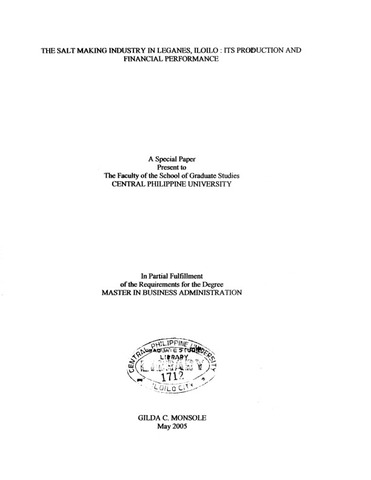The salt making industry in Leganes, Iloilo: Its production and financial performance

Page views
8,604Date
2005Author
Thesis Adviser
Defense Panel Chair
Share
Metadata
Show full item record
Abstract
The study was conducted to determine the production and financial performance of the salt making industry in the municipality of Leganes, Iloilo. The target population study was eighty nine salt producers in four barangays in Leganes currently producing salt namely: Barangay M. V. Hechanova, Barangay Napnud, Barangay Gua-an, and Barangay Nabitasan.
The descriptive research design with the aid of a one-shot survey was used. A self-administered questionnaire was prepared and distributed to the respondents. The data were encoded and analyzed using the Statistical Package. Means, One-way Anova and Pearson r was used to determine the relationship and variation of variables under study.
It was found out that there is a significant relationship between the sources of capital and financial performance of the salt producers in terms of profits before tax. The more salt producers obtain capital from NGOs, Banks, Financial Institutions and own savings, the more profits they would have realized. There is a significant relationship between the type of salt produced by the salt producers and their financial performance in terms of profits before tax. The more the salt producers produced iodized salt, the more profits they would earn. The type of the distribution system used by the salt producers in selling their products has no significant relationship on their financial performance in terms of profits before taxes. Profits before taxes of the salt producers have not been affected regardless of their distribution system used. On the other hand, there is a significant relationship between the systems used by the salt producers in paying the wages of their laborers and their financial performance. Salt producer’s profits before taxes was higher in using the fixed rate system compared to the tenancy or (agsa) system, and finally, there is a significant difference in the amount of capital and the financial performance of the salt producers in terms of profits before taxes. Profits were not significantly affected by the selling practices used by the salt producers in selling their products. Profits of the salt producers were not significantly affected by the location of their salt beds. Profits of the salt producers have significant difference on the type of salt beds they using. Those who were using bricks have better profits compared to plastics salt beds. Salt producers who have the longer preparation to harvest period had a higher income compared to salt producers with a lesser period of preparation. Those who have a longer preparation to harvest period were land owners who have the big number of salt beds, naturally profits was higher also. There was a significant relationship between the production volume and profits before taxes. This means that the higher volume the higher profits. There was a significant relationship between the labor cost and the profits of the salt producers. The higher the labor cost, the lower the profits. As can be observed the mean profits under the fixed system is higher compared to the agsa system because it has lower labor cost. There was a significant relationship between the number of laborers and profits before taxes of the salt producers. This means that the higher the number of the laborer, the higher the labor cost, the lower the profits. There was no significant relationship between the selling price and the profits of the salt producers taken as a group.
Description
Abstract only
Suggested Citation
Monsole, G. C. (2005). The salt making industry in Leganes, Iloilo: Its production and financial performance (Unpublished Master's special paper). Central Philippine University, Jaro, Iloilo City.
Type
Special paperSubject(s)
Department
School of Graduate StudiesDegree
Master in Business AdministrationShelf Location
GSL Theses 650.072 M759
Physical Description
xi, 116 leaves

